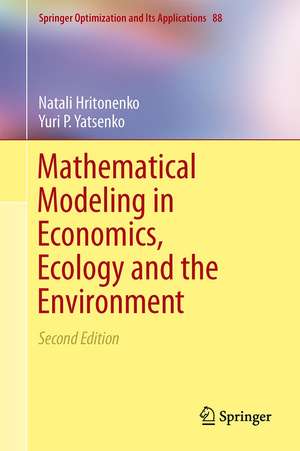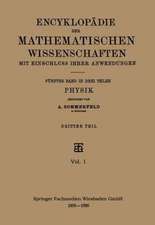Mathematical Modeling in Economics, Ecology and the Environment: Springer Optimization and Its Applications, cartea 88
Autor Natali Hritonenko, Yuri Yatsenkoen Limba Engleză Hardback – 9 ian 2014
Core topics of this text are:
· Economic growth and technological development
· Population dynamics and human impact on the environment
· Resource extraction and scarcity
· Air and water contamination
· Rational management of the economy and environment
· Climate change and global dynamics
The step-by-step approach taken is problem-based and easy to follow. The authors aptly demonstrate that the same models may be used to describe different economic and environmental processes and that similar investigation techniques are applicable to analyze variousmodels. Instructors will appreciate the substantial flexibility that this text allows while designing their own syllabus. Chapters are essentially self-contained and may be covered in full, in part, and in any order.
Appropriate one- and two-semester courses include, but are not limited to, Applied Mathematical Modeling, Mathematical Methods in Economics and Environment, Models of Biological Systems, Applied Optimization Models, and Environmental Models. Prerequisites for the courses are Calculus and, preferably, Differential Equations.
| Toate formatele și edițiile | Preț | Express |
|---|---|---|
| Paperback (1) | 455.71 lei 6-8 săpt. | |
| Springer Us – 23 aug 2016 | 455.71 lei 6-8 săpt. | |
| Hardback (1) | 534.69 lei 6-8 săpt. | |
| Springer Us – 9 ian 2014 | 534.69 lei 6-8 săpt. |
Din seria Springer Optimization and Its Applications
- 15%
 Preț: 642.00 lei
Preț: 642.00 lei - 15%
 Preț: 664.61 lei
Preț: 664.61 lei - 18%
 Preț: 961.55 lei
Preț: 961.55 lei - 17%
 Preț: 360.79 lei
Preț: 360.79 lei - 13%
 Preț: 458.08 lei
Preț: 458.08 lei -
 Preț: 336.79 lei
Preț: 336.79 lei - 18%
 Preț: 787.91 lei
Preț: 787.91 lei - 17%
 Preț: 397.79 lei
Preț: 397.79 lei - 8%
 Preț: 337.37 lei
Preț: 337.37 lei - 18%
 Preț: 1133.30 lei
Preț: 1133.30 lei - 15%
 Preț: 646.43 lei
Preț: 646.43 lei - 15%
 Preț: 647.40 lei
Preț: 647.40 lei -
 Preț: 400.47 lei
Preț: 400.47 lei -
 Preț: 379.86 lei
Preț: 379.86 lei -
 Preț: 383.90 lei
Preț: 383.90 lei -
 Preț: 388.48 lei
Preț: 388.48 lei -
 Preț: 546.26 lei
Preț: 546.26 lei - 15%
 Preț: 647.40 lei
Preț: 647.40 lei -
 Preț: 390.25 lei
Preț: 390.25 lei - 15%
 Preț: 649.87 lei
Preț: 649.87 lei - 24%
 Preț: 611.55 lei
Preț: 611.55 lei - 18%
 Preț: 972.62 lei
Preț: 972.62 lei - 20%
 Preț: 585.91 lei
Preț: 585.91 lei - 15%
 Preț: 710.09 lei
Preț: 710.09 lei - 18%
 Preț: 742.61 lei
Preț: 742.61 lei - 15%
 Preț: 658.22 lei
Preț: 658.22 lei - 15%
 Preț: 659.02 lei
Preț: 659.02 lei - 18%
 Preț: 745.15 lei
Preț: 745.15 lei - 15%
 Preț: 705.34 lei
Preț: 705.34 lei
Preț: 534.69 lei
Preț vechi: 629.04 lei
-15% Nou
Puncte Express: 802
Preț estimativ în valută:
102.31€ • 107.09$ • 85.16£
102.31€ • 107.09$ • 85.16£
Carte tipărită la comandă
Livrare economică 31 martie-14 aprilie
Preluare comenzi: 021 569.72.76
Specificații
ISBN-13: 9781461493105
ISBN-10: 1461493102
Pagini: 316
Ilustrații: XVII, 296 p. 34 illus., 8 illus. in color.
Dimensiuni: 155 x 235 x 23 mm
Greutate: 0.62 kg
Ediția:2nd ed. 2013
Editura: Springer Us
Colecția Springer
Seria Springer Optimization and Its Applications
Locul publicării:New York, NY, United States
ISBN-10: 1461493102
Pagini: 316
Ilustrații: XVII, 296 p. 34 illus., 8 illus. in color.
Dimensiuni: 155 x 235 x 23 mm
Greutate: 0.62 kg
Ediția:2nd ed. 2013
Editura: Springer Us
Colecția Springer
Seria Springer Optimization and Its Applications
Locul publicării:New York, NY, United States
Public țintă
GraduateCuprins
Preface.- 1. Introduction: Principles and Tools of Mathematical Modeling. Part I. Models of Controlled Economic Systems.- 2. Aggregate Models of Economic Dynamics.- 3. Modeling of Technological Change.- 4. Models with Heterogeneous Capital.- 5. Optimization of Economic Renovation.- Part II. Models in Ecology and Environment.- 6. Mathematical Models of Biological Populations.- 7. Modeling and Control of Biological Communities.- 8. Models of Air Pollution Propagation.- 9. Models of Water Pollution Propagation.- Part III. Models of Economic-Environmental Systems.- 10. Modeling of Non-Renewable Resources.- 11. Modeling of Environmental Protection.- 12. Models of Global Dynamics: from the Club of Rome to Integrated Assessment.- Index.
Recenzii
From the book reviews:
“This book contains a wealth of information on many of the models used in describing economic and environmental changes. … this is a very well written and very thorough introduction to mathematical modeling in economics and the environment. It is a valuable ‘first source’ on basic modeling that is accessible to a graduate student level or professional audience.” (Mary Flagg, MAA Reviews, October, 2014)
“This book contains a wealth of information on many of the models used in describing economic and environmental changes. … this is a very well written and very thorough introduction to mathematical modeling in economics and the environment. It is a valuable ‘first source’ on basic modeling that is accessible to a graduate student level or professional audience.” (Mary Flagg, MAA Reviews, October, 2014)
Notă biografică
Natali Hritonenko is an award-winning professor of mathematics at Prairie View A&M University. She has traveled the world sharing her research results through numerous presentations and collaborating on groundbreaking research projects with a diverse team of leading experts. During her prolific career, Dr. Hritonenko has authored 7 books and well over 100 papers, and is also on the editorial board of 9 international interdisciplinary journals. Her real passion, however, is teaching and she aims to bring the fascinating and versatile nature of mathematics to her students, while also revealing to them the insights that mathematics can bring to any subject.
Dr. Yuri Yatsenko has published seven books and over 200 papers. He earned his MS and PhD from Kiev State University and a Doctor of Science from the USSR Academy of Sciences (Moscow). During his career, he has been a professor in five different countries and taught mathematics, statistics, economics, information systems, and computer sciences in four languages. For five years, he held senior positions in data analytics and operations research at international companies in USA and Canada. He joined Houston Baptist University in 2002 and is currently engaged in intensive collaboration with several European and Asian universities. His areas of expertise include modeling and optimization of economic, industrial, and environmental processes, technological change, innovations, operations research, and computational methods.
Dr. Yuri Yatsenko has published seven books and over 200 papers. He earned his MS and PhD from Kiev State University and a Doctor of Science from the USSR Academy of Sciences (Moscow). During his career, he has been a professor in five different countries and taught mathematics, statistics, economics, information systems, and computer sciences in four languages. For five years, he held senior positions in data analytics and operations research at international companies in USA and Canada. He joined Houston Baptist University in 2002 and is currently engaged in intensive collaboration with several European and Asian universities. His areas of expertise include modeling and optimization of economic, industrial, and environmental processes, technological change, innovations, operations research, and computational methods.
Textul de pe ultima copertă
Updated to textbook form by popular demand, this second edition discusses diverse mathematical models used in economics, ecology, and the environmental sciences with emphasis on control and optimization. It is intended for graduate and upper-undergraduate course use, however, applied mathematicians, industry practitioners, and a vast number of interdisciplinary academics will find the presentation highly useful.
Core topics of this text are:
· Economic growth and technological development
· Population dynamics and human impact on the environment
· Resource extraction and scarcity
· Air and water contamination
· Rational management of the economy and environment
· Climate change and global dynamics
The step-by-step approach taken is problem-based and easy to follow. The authors aptly demonstrate that the same models may be used to describe different economic and environmental processes and that similar investigation techniques are applicable to analyze various models. Instructors will appreciate the substantial flexibility that this text allows while designing their own syllabus. Chapters are essentially self-contained and may be covered in full, in part, and in any order.
Appropriate one- and two-semester courses include, but are not limited to, Applied Mathematical Modeling, Mathematical Methods in Economics and Environment, Models of Biological Systems, Applied Optimization Models, and Environmental Models. Prerequisites for the courses are Calculus and, preferably, Differential Equations.
Core topics of this text are:
· Economic growth and technological development
· Population dynamics and human impact on the environment
· Resource extraction and scarcity
· Air and water contamination
· Rational management of the economy and environment
· Climate change and global dynamics
The step-by-step approach taken is problem-based and easy to follow. The authors aptly demonstrate that the same models may be used to describe different economic and environmental processes and that similar investigation techniques are applicable to analyze various models. Instructors will appreciate the substantial flexibility that this text allows while designing their own syllabus. Chapters are essentially self-contained and may be covered in full, in part, and in any order.
Appropriate one- and two-semester courses include, but are not limited to, Applied Mathematical Modeling, Mathematical Methods in Economics and Environment, Models of Biological Systems, Applied Optimization Models, and Environmental Models. Prerequisites for the courses are Calculus and, preferably, Differential Equations.
Caracteristici
Exposes modern practice of applied mathematical modeling in economics, population biology, and environmental sciences Studied relations among various economic, population, and environmental models Demonstrates how integrated mathematical models are built from simple components Explains investigation techniques for models and provides interpretation of results Includes supplementary material: sn.pub/extras



























